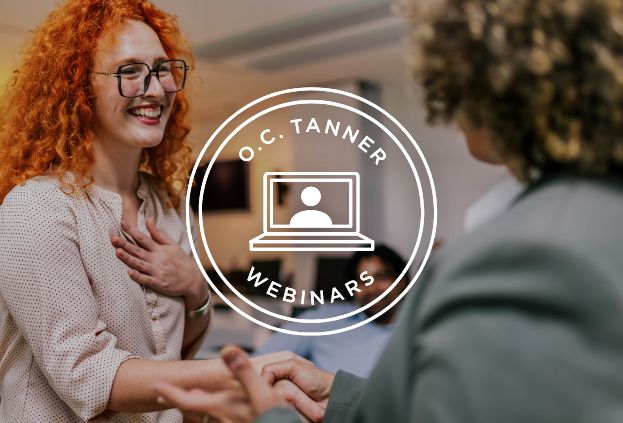How to Effectively Prepare for a Recognition Program Rollout

Updated on
March 17, 2025
17
March
2025
Employee recognition is crucial to building a thriving culture and engaged workforce. As you implement and grow your recognition solutions, you’ll want to be fully prepared—so you can prevent issues that might delay the rollout of your new tools and programs.
You don’t want to spend precious time and money searching for the right employee recognition solutions only to have to pause or cancel implementation due to unforeseen issues. Here’s how to fully understand your business and solution requirements and anticipate roadblocks, so you can roll out successful and meaningful employee recognition at your organization.
The importance of investing in employee recognition
Saying thanks isn’t a luxury. As employees continue to look for fulfilling, meaningful work, they want to know what they do matters and their organizations appreciate them. And when times feel uncertain and unpredictable, recognizing employees is more important than ever.
Employee recognition isn’t just something that’s nice to do—it has a real impact on business results:
- Companies with recognition programs see 31% lower turnover than companies without
- Organizations with highly integrated recognition are 2x more likely to have experienced an increase in revenue over the past year and 73% less likely to have had layoffs in the past year
- Employees who are recognized are 33% more productive and generate 2x as many new ideas per month
Highly integrated recognition increases the odds of:
- Great work (+1,181%)
- High engagement (+784%)
- Thriving culture (+648%)
- Lower employee burnout (–80%)
Since recognition is vital to an organization’s success, it’s important to ensure you provide a robust solution that works for your entire organization.

Common issues that can hinder the rollout of employee recognition programs
We’ve seen companies who are excited about launching a new recognition solution run into major issues that can delay implementation. Being prepared to address these issues, before you even begin implementation, is key to a successful rollout. Here are some common issues:
1. Not knowing your requirements
There can be misunderstanding, miscommunication, and misalignment between the recognition solutions companies want to implement and what they are able to implement.
Employee recognition solutions touch all areas of a company (HR, finance, IT, individual business units, global locations, etc.) so it’s important to fully understand the needs and requirements of those areas. Oftentimes a recognition solution may be implemented by a different group than the one that purchased the solution and there may be technology, process, or financial needs that conflict between the buying group and implementation team.
Knowing your business requirements—in all areas of your business—and ensuring your chosen solution or partner can support these requirements should be a top priority. Same goes for understanding how decisions get made and who makes those decisions, so you can get key stakeholder involvement and buy-in sooner.
Navigating unions and work councils in recognition
Many organizations have unions or work councils that need to be consulted when implementing a new solution like employee recognition. Here are three ways to manage this relationship:
- Involve them early in the process and develop a solution together with them.
- Show how a company-wide recognition solution will provide an equitable, consistent experience for all employees. How does it benefit employees and enhance their employee experience?
- Ask for their feedback and address their concerns. Navigating union and work council requirements can be tricky but can be successfully done if you approach it in a true spirit of collaboration.
2. Forgetting the small details
There are so many decisions to be made when rolling out a new recognition solution—it can be easy to get caught up in the excitement of it all. But neglecting to think of all the small details can turn into big problems later. Consider:
- How will your recognition technology integrate with your existing tech solutions?
- How will you be invoiced?
- How will awards be distributed?
- How will your offline employees have access to new recognition tools?
Like a blueprint for building a house, a plan for rolling out a recognition solution is crucial to success. Your recognition partner or vendor should have expertise in this and be able to provide a list of things to consider. Go through it carefully with your team of stakeholders to make sure all of their needs and requirements are addressed.
3. Competing priorities and lack of resources
There are always competing resources and priorities in an organization. Your teams might need to upgrade your benefits platform, overhaul your data security systems, or lead your annual employee experience survey—all in the same quarter. With limited resources and endless projects, it is inevitable that one of your initiatives will have to wait.
Something will always come up in the workplace that takes time, attention, and resources away from what you have planned. But recognition really matters, and culture should always be a strategic imperative for companies.
Build the business case for recognition, get executive buy-in and support for it, and connect recognition and culture to your organization’s strategic objectives. Doing this gives your recognition initiative a better chance of staying at the top of the company priority list.
4. Changing of the guard
Even with the best of intentions, changes in the workplace can put the rollout of a recognition solution on pause. Most of the time this is due to a big organizational change: change in company leadership, reorganizations or layoffs, or even reassignments in who is leading the implementation of a recognition solution can put things off kilter.
But the truth is, recognition is even more important when organizations are facing big changes. You’ve already made much progress in getting executive buy-in, energizing employees, and preparing the organization for a new recognition solution—you don’t want to lose the momentum.
Keep recognition top of mind and show how a new recognition approach, aligned with your culture, can actually help the organization navigate these changes and positively impact employee experience after they happen.

What can you do if your employee recognition rollout is put on hold?
If you are waiting to roll out your recognition solutions because of one of the situations above, here are a few things you can do in the meantime:
Keep recognition top of mind and maintain executive support
Don’t let your recognition solution fall off the priority list—regularly remind your executives that your solution launch is waiting for the green light. Bring up recognition in senior leader meetings, send reminders to check on status, and get help from your executive sponsor.
Ensure all the details are in place for when you get approval to proceed
Take this opportunity to circle back with key stakeholders and ensure all the details have been covered, questions and possible issues have been addressed, and everything is ready for when you are able to launch.
Use the time to perfect change plans
Refine your change strategy and plan. This includes ensuring all communication and education elements are complete and in place for roll out. Double check that recognition promotions, communication, and training are embedded in your employees’ flow of work—and that recognition is integrated into your employee lifecycle and company culture.
Continue to recognize your people
Just because your new solution may be on hold doesn’t mean you have to pause recognition. Some low cost ways to recognize include written thank you notes, verbal recognition in meetings, gathering together to celebrate service anniversaries, and holding celebration events for company milestones and accomplishments.

CIBC didn’t let a global pandemic stop recognition. While they had planned to launch their MomentMakers recognition solution in the spring of 2020, the worldwide spread of Covid forced them to pause. After a few months of patiently waiting to see the pandemic’s effects on the workplace, CIBC launched their solution later that year.
Because of their careful preparation and planning, even a worldwide crisis didn’t dampen CIBC’s success. By understanding their business requirements, making recognition a priority, and keeping the support of their CEO, CIBC’s efforts led to:
- Over 215,000 recognition moments in the first year
- Over 70% of employees receiving recognition in the first year
- A 5x increase in eCard usage compared to their previous program
- A 9x increase in award nominations compared to their previous program
- 90% of employees saying, “My manager gives me recognition for a job well done” (6% higher than the industry benchmark and an increase of 7% from the previous year)
- 85% of employees feel “My personal contributions are recognized” (8% higher than the industry benchmark)
Are you thinking through your recognition program wish list? Here are the program features you need to consider.

A research analyst with nearly 20 years’ experience, Christina uncovers employee perceptions and writes about the trends, insights, and best practices that create workplace cultures where people thrive. She uses her background in conducting and publishing primary research to tap into what the data says and why it matters to modern leaders. Christina has a bachelor’s in sociology from the University of Michigan and a master’s in marketing from Northwestern University.
A research analyst with nearly 20 years’ experience, Christina uncovers employee perceptions and writes about the trends, insights, and best practices that create workplace cultures where people thrive. She uses her background in conducting and publishing primary research to tap into what the data says and why it matters to modern leaders. Christina has a bachelor’s in sociology from the University of Michigan and a master’s in marketing from Northwestern University.
A research analyst with nearly 20 years’ experience, Christina uncovers employee perceptions and writes about the trends, insights, and best practices that create workplace cultures where people thrive. She uses her background in conducting and publishing primary research to tap into what the data says and why it matters to modern leaders. Christina has a bachelor’s in sociology from the University of Michigan and a master’s in marketing from Northwestern University.




